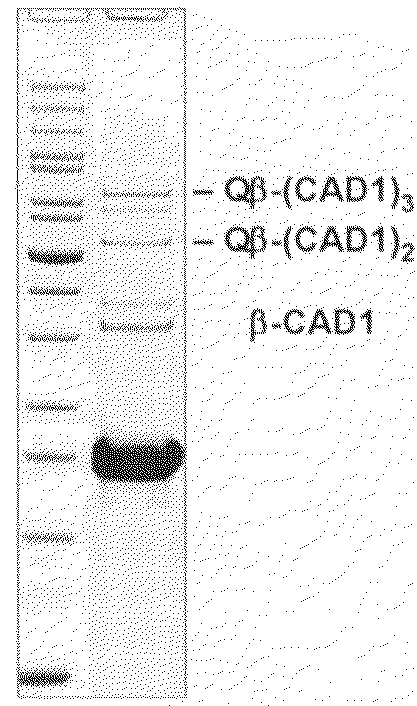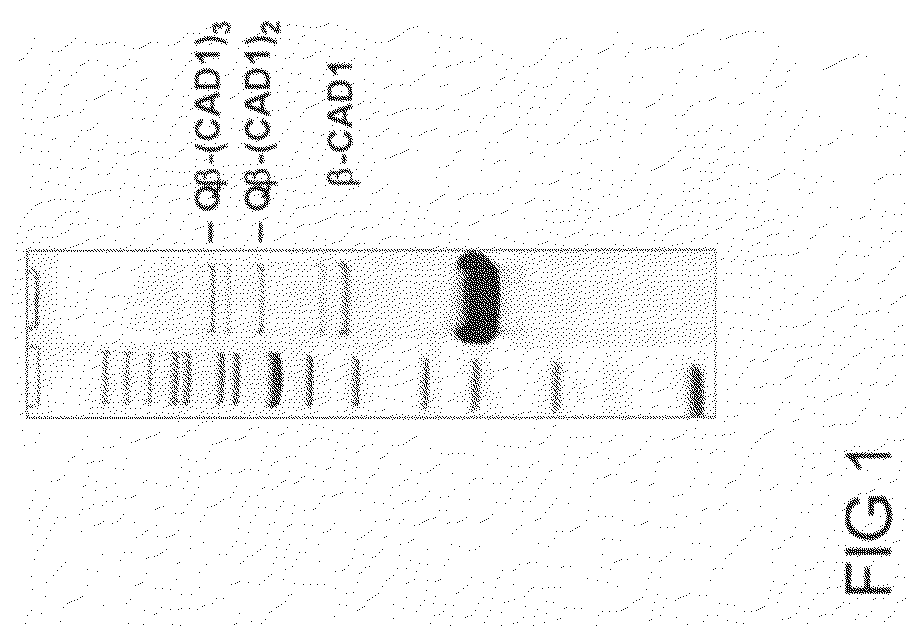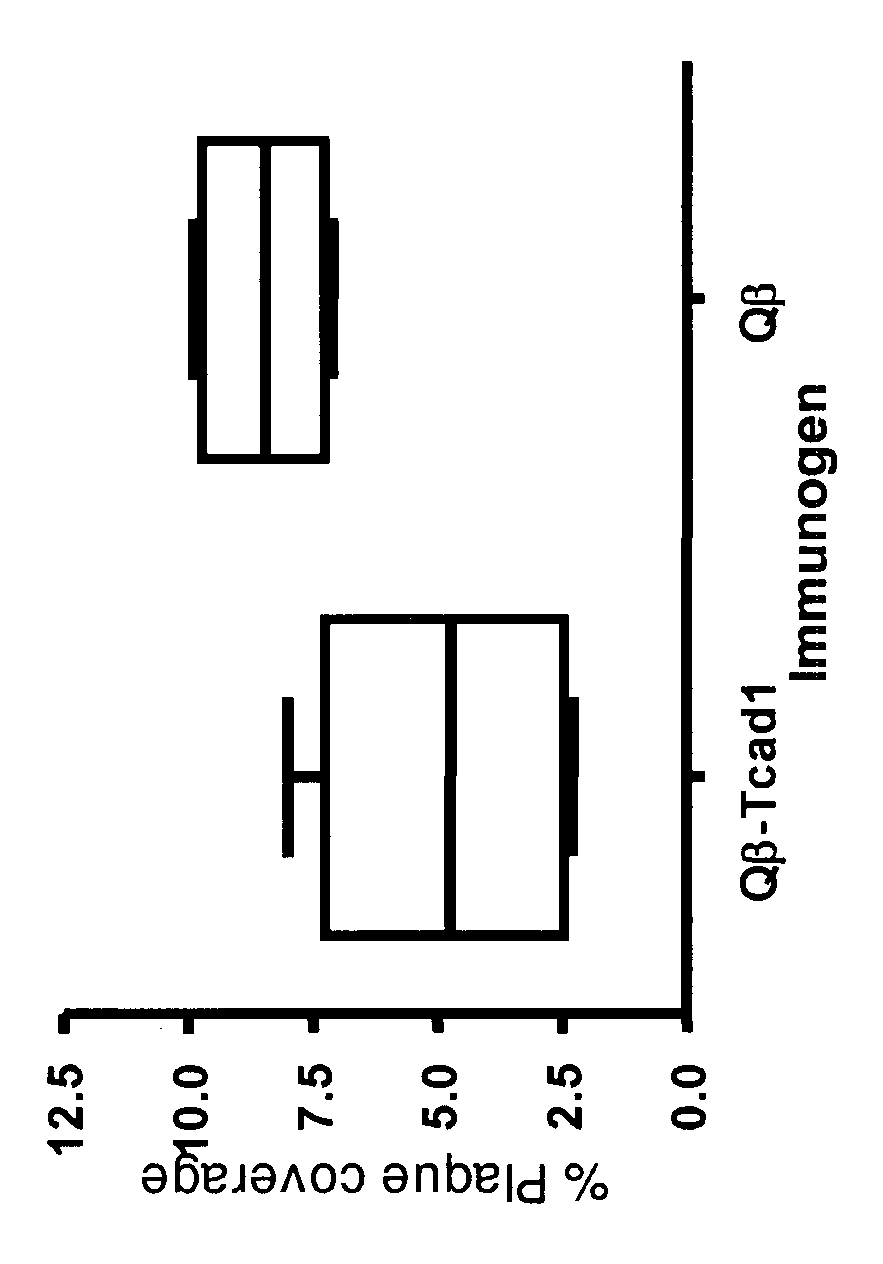T-Cadherin antigen arrays and uses thereof
a technology of cadherin and antigens, applied in the field of medicine, public health, immunology, molecular biology and virology, can solve the problems of lack of transmembrane domain and cytoplasmic domain of other members of the cadherin family, and achieve the effects of reducing the production cost of inventive compositions and vaccines, reducing the possibility of self-specific cytotoxic t cell responses, and reducing the possibility of unwanted inflammatory t cell responses
- Summary
- Abstract
- Description
- Claims
- Application Information
AI Technical Summary
Benefits of technology
Problems solved by technology
Method used
Image
Examples
example 1
Cloning of the T-Cadherin CAD1
[0135]A cDNA library derived from differentiated mouse C2C12 cells was used as a template for PCR amplification of CAD1 (SEQ ID NO:24), using the primer pair Fwd CAD-3: CTAGCTAGCTCCATTGTGGTGTCCCCCA (SEQ ID NO: 29) Rev-CAD-6: CTACTCGAGGAAGATGGGTCTGTTGTCG (SEQ ID NO: 30). The forward primer contains a NheI site and the reverse primer an XhoI site allowing the cloning of CAD1 into plasmid pMOD-EC3 (as described in EXAMPLE 4 of US 2003-0175290-A1). The PCR fragment was cloned into pMOD-EC3 and clones were sequenced, the resulting plasmid was named pMOD-C6xCAD1.
example 2
Expression and Purification of His-Tagged CAD1
[0136]The plasmid pMOD-C6xCAD1 was transformed into the bacterial expression strain BL21 (DE3) (Novagen). The expression was induced at OD600 of 1.0 by adding IPTG to a final concentration of 1 mM. The culture was grown for an additional 3 hours and the cells harvested by centrifugation. The cells were resuspended in 10 ml ice-cold native lysis buffer (50 mM NaH2PO4, 300 mM NaCl, 10 mM imidazole pH 8.0) and disrupted by sonication.
[0137]The clarified bacterial lysate was brought to 50 ml with native lysis buffer: One ml of nickel-nitrilotriacetic acid (Ni-NTA) agarose (Qiagen) was added to the lysate and the lysate was further incubated by inverting for 1 hour at 4° C. allowed binding of the His-tagged CAD1 fusion protein to the agarose.
[0138]The collected agarose was washed by lysis buffer for 4 times. Bound protein was eluted by resuspension of the Ni-NTA agarose in 2 ml of elution buffer (50 mM NaH2PO4, 300 mM NaCl, 250 mM imidazole p...
example 3
Coupling by Chemical Cross-Linking of CAD1 to Prior Art Qβ VLPs
[0139]A solution of 143 μM prior art Qβ VLP in HEPES buffer (20 mM HEPES, 150 mM NaCl, pH 7.2) was reacted with a 5-fold molar excess (715 μM) of SMPH (Pierce) for 30 minutes at 25° C. with shaking. Reaction products were dialyzed against two changes of Dulbecco's PBS (Gibco) using a dialysis unit with a 10,000 Da molecular weight cutoff (Slide-A-Lyzer, Pierce).
[0140]Stored CAD1 aliquots and SMPH-derivatized Qβ VLPs were thawed to room temperature. Before coupling, CAD1 was incubated with TCEP (Pierce, Perbio Science) in equimolar amounts for 30 minutes at room temperature. Subsquently, CAD1 was added in a 5-fold molar excess to a 143 μM SMPH-derivatized Qβ VLPs. Reaction volume was 650 μl and multiple reactions were performed in parallel. Reactions were incubated for 4 hours at room temperature with shaking. After coupling, aliquots were centrifuged at 16,000×g for 3 minutes at 4° C. to pellet insoluble material. The su...
PUM
| Property | Measurement | Unit |
|---|---|---|
| diameter | aaaaa | aaaaa |
| molecular weight | aaaaa | aaaaa |
| molecular weight | aaaaa | aaaaa |
Abstract
Description
Claims
Application Information
 Login to View More
Login to View More - R&D
- Intellectual Property
- Life Sciences
- Materials
- Tech Scout
- Unparalleled Data Quality
- Higher Quality Content
- 60% Fewer Hallucinations
Browse by: Latest US Patents, China's latest patents, Technical Efficacy Thesaurus, Application Domain, Technology Topic, Popular Technical Reports.
© 2025 PatSnap. All rights reserved.Legal|Privacy policy|Modern Slavery Act Transparency Statement|Sitemap|About US| Contact US: help@patsnap.com



